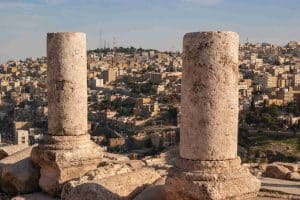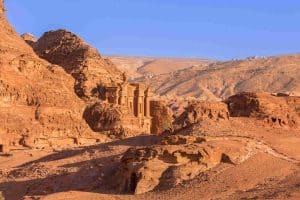Wadi Araba is a very large geographical area located in the southwest of Jordan. And you may have heard of it for different reasons: religion, politics, nature… In this post we tell you where it is and why it can be interesting to go to this area that is so little inhabited and exploited by international tourism .
Where is Wadi Araba and what is it?
The name Wadi Araba is made up of two Arabic words that tell us about its identity: wadi can be translated as “dry valley”, while araba would be equivalent to “desert” or “savannah” and is a term that has been used for many areas of the Middle East, such as Saudi Arabia. This term, in turn, could derive from the Hebrew arava, which is used in some contexts to refer to this expanse of land, such as in the Bible.
It is therefore a large valley turned into a desert, stretching from the southern coast of the Black Sea to the Gulf of Aqaba. It is therefore a natural extension of the Jordan Valley and, in fact, in the Bible it also appears as the “Valley of Salt”, in reference to the salty waters of the Dead Sea, at its source. The border between Jordan and Israel, which is about 200 km long, also runs through here.
In the Jordanian part of Wadi Araba, the population density is minimal, as there are hardly any towns and settlements, connected by Jordan Valley Highway. On the Israeli side, on the other hand, small towns or even kibbutzim or agricultural communes are more abundant.
Wadi Araba in the Bible and today
For many, Wadi Araba is known for its mention in the Bible and for the peace treaty signed here. In the case of the biblical account, Arabah is mentioned as a land of passage for the Israelites, on their journey from Egypt to the Promised Land, led by Moses, who later had to climb Mount Nebo to contemplate it.
And in much more recent times, in 1994 an important peace treaty between Israel and Jordan was signed on the Israeli side of Wadi Araba, which was named after him. This agreement, sponsored by then-U.S. President Bill Clinton and signed by Israeli Prime Minister Yitzhak Rabin and his Jordanian counterpart Abdul Salam Majali, served to establish diplomatic relations and agreements on the border line and other aspects.
In and around Wadi Araba
As it is a large uninhabited area, the tourist attractions are not numerous, but this desert ecosystem can be an attraction in itself for nature lovers and hikers. From certain high points you can enjoy panoramic views of the surroundings, such as if you take the route of the back door of Petra.
And going into it can be a good option to spot native fauna, from resident and migratory birds (teal, warbler, Dead Sea sparrow, etc.) to reptiles (headband snakes, native lizards, etc.) and even mammals, among which the caracal feline stands out.
Adventure lovers, on the other hand, have some (few) options for quad, buggy and 4×4 riding to ride the arid tracks of Wadi Araba. For example, at the Rahma Visitor Centre, about a two-hour drive from Petra, where activities of this type are organised, often aimed at Jordanian citizens themselves who wish to get to know this desert in their country.
In any case, if you want to include a Wadi Araba experience in your tour, whether it’s hiking, nature observation or adventure, don’t hesitate to let us know during the configuration phase of your travel package.







